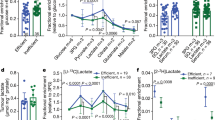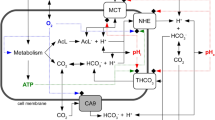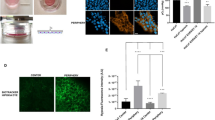Abstract
The response to treatment and the malignant progression of tumours are influenced by the ability of the tumour cells to withstand severe energy deprivation during prolonged exposure to hypoxia at normal or low extracellular pH (pHe). The objective of the present work was to demonstrate intertumour heterogeneity under conditions of microenvironment-induced energy deprivation and to investigate whether the heterogeneity can be attributed to differences in the capacity of the tumour cells to generate energy in an oxygen-deficient microenvironment. Cultures of four human melanoma cell lines (BEX-c, COX-c, SAX-c, WIX-c) were exposed to hypoxia in vitro at pHe 7.4, 7.0 or 6.6 for times up to 31 h by using the steel-chamber method. High-performance liquid chromatography was used to assess adenylate energy charge as a function of exposure time. Cellular rates of glucose uptake and lactate release were determined by using standard enzymatic test kits. The adenylate energy charge decreased with time under hypoxia in all cell lines. The decrease was most pronounced shortly after the treatment had been initiated and then tapered off. BEX-c and SAX-c showed a significantly higher adenylate energy charge under hypoxic conditions than did COX-c and WIX-c whether the pHe was 7.4, 7.0 or 6.6, showing that tumours can differ in the ability to avoid energy deprivation during microenvironmental stress. There was no correlation between the adenylate energy charge and the rates of glucose uptake and lactate release. Intertumour heterogeneity in the ability to withstand energy deprivation in an oxygen-deficient microenvironment cannot therefore be attributed mainly to differences in the capacity of the tumour cells to generate energy by anaerobic metabolism. The data presented here suggest that the heterogeneity is rather caused by differences in the capacity of the tumour cells to reduce the rate of energy consumption when exposed to hypoxia.
This is a preview of subscription content, access via your institution
Access options
Subscribe to this journal
Receive 24 print issues and online access
$259.00 per year
only $10.79 per issue
Buy this article
- Purchase on Springer Link
- Instant access to full article PDF
Prices may be subject to local taxes which are calculated during checkout
Similar content being viewed by others
Author information
Authors and Affiliations
Rights and permissions
About this article
Cite this article
Skøyum, R., Eide, K., Berg, K. et al. Energy metabolism in human melanoma cells under hypoxic and acidic conditions in vitro. Br J Cancer 76, 421–428 (1997). https://doi.org/10.1038/bjc.1997.405
Issue Date:
DOI: https://doi.org/10.1038/bjc.1997.405
This article is cited by
-
Effects of tumour acidification with glucose+MIBG on the spontaneous metastatic potential of two murine cell lines
British Journal of Cancer (2004)



